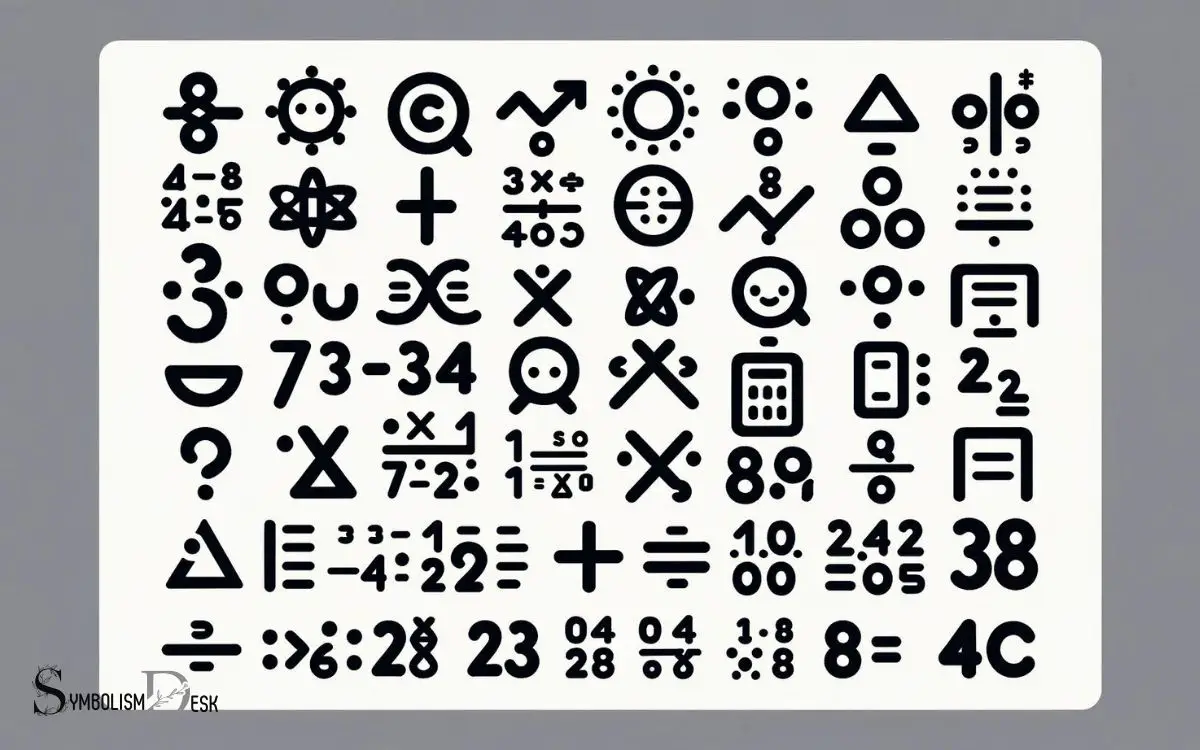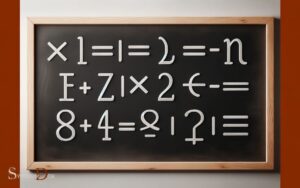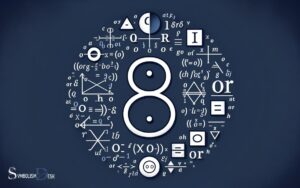Math Symbols Order of Operation: Explain!
The order of operations in mathematics dictates the sequence in which mathematical operations should be performed to ensure consistent results.
The standard order is Parentheses, Exponents, Multiplication and Division (from left to right), and Addition and Subtraction (from left to right), often remembered by the acronym PEMDAS.
When solving a mathematical equation or expression, it is crucial to follow the correct order of operations:
For example, in the expression (3 + 4 \times 2^2), you would first calculate the exponent ((2^2 = 4)), then the multiplication ((4 \times 4 = 16)), and finally, you would add 3 to get the result 19.
Understanding the order of operations is essential for correctly solving mathematical problems and avoiding mistakes in complex calculations.

Key Takeaway
The Significance of Math Symbols
The significance of math symbols lies in their ability to precisely convey the order and relationship of operations within mathematical expressions. Without these symbols, it would be challenging to express complex mathematical concepts concisely and accurately.
For instance, the use of parentheses clarifies which operations should be performed first, while symbols like “+” and “-” indicate addition and subtraction.
Furthermore, symbols like “√” represent square roots and “π” represents the constant pi. Each symbol has a specific meaning and function, allowing mathematicians and scientists to communicate ideas universally.
Understanding these symbols is essential for interpreting mathematical expressions correctly and solving equations accurately.
In essence, math symbols serve as a standardized language that enables the clear communication of mathematical concepts and operations.
Understanding Parentheses and Brackets
When it comes to mathematical expressions, understanding the use of parentheses and brackets is crucial for accurate calculations.
Differentiating between parentheses and brackets, as well as recognizing nested grouping symbols, can significantly impact the outcome of mathematical operations.
Therefore, it is important to grasp the distinctions and implications of using these symbols in mathematical expressions.
Parentheses Vs. Brackets
Parentheses and brackets are essential symbols in mathematics for grouping and organizing expressions. While both serve the purpose of grouping terms together, they have distinct functions.
Parentheses, denoted by the symbols ( and ), are primarily used to indicate the order of operations within an expression.
They clarify which operations should be performed first. On the other hand, brackets, denoted by the symbols [ and ], are commonly utilized to group terms within a mathematical expression, particularly when dealing with nested parentheses.
Brackets are valuable for providing further clarity and organization within mathematical equations.
Understanding the differences and applications of parentheses and brackets is crucial for correctly interpreting mathematical expressions and ensuring accurate calculations.
Therefore, a solid grasp of the specific roles of parentheses and brackets is fundamental for mathematical proficiency.
Nested Grouping Symbols
In mathematical expressions, the use of both parentheses and brackets is essential for accurately grouping and organizing terms, particularly when dealing with nested operations. Understanding nested grouping symbols is vital for solving complex equations.
Here are a few key points to consider:
- Nested Parentheses: When parentheses are used within other parentheses, it signifies the innermost operation.
- Bracket Usage: Brackets are typically used for clarity when there are already parentheses in the expression.
- Clarity and Organization: Both parentheses and brackets help to clearly demarcate different parts of an equation, improving its readability and reducing ambiguity.
Understanding the proper use of nested grouping symbols is crucial for tackling intricate mathematical problems. It impacts the efficiency and accuracy of calculations, ensuring that the order of operations is correctly followed.
Impact on Calculations
The use of nested parentheses and brackets significantly influences the accuracy and efficiency of mathematical calculations. Understanding the impact of these nested grouping symbols is crucial for solving complex equations.
The following table illustrates the order of operations when using parentheses and brackets:
| Operation | Example | Result |
|---|---|---|
| Parentheses first | 5 * (3 + 2) | 25 |
| Brackets first | 4 * [2 + (3 * 2)] | 28 |
| Nested parentheses | 2 * (3 + (4 – 1)) | 14 |
Exploring the Power of Exponents
First introduced in the 16th century, exponents are powerful mathematical tools used to represent repeated multiplication. They simplify calculations and are fundamental in various mathematical concepts. Understanding the power of exponents is essential for mastering higher levels of math.
Here are some key points to consider:
- Exponents show how many times a number is multiplied by itself.
- They follow specific rules for multiplication, division, and exponentiation.
- Exponents are used in various real-world applications, such as compound interest calculations and scientific notation.
Mastering exponents is crucial for grasping advanced mathematical concepts and is a foundational skill for students pursuing fields like engineering, physics, and computer science.
Multiplication and Division Rules
When performing mathematical operations involving both multiplication and division, it is crucial to adhere to the correct order of operations. The general rule is to carry out multiplication before division and to proceed from left to right.
This fundamental principle ensures accuracy and consistency in mathematical calculations, forming the basis for solving complex equations and problems.
Multiplication Before Division
In mathematical operations, multiplication is performed before division to establish the correct order of computation.
This rule is known as the multiplication before division rule and is a fundamental aspect of the order of operations in mathematics. When solving mathematical expressions, it is crucial to understand and apply this rule to ensure accurate results.
To clarify, consider the following key points:
- Multiplication is given priority over division in the order of operations.
- When a mathematical expression contains both multiplication and division, the multiplication is carried out first.
- It is essential to adhere to the multiplication before division rule to avoid errors in solving mathematical problems.
Understanding and applying the multiplication before division rule is fundamental to mastering the order of operations in mathematics.
Follow Left to Right
Continuing from the previous subtopic on the order of operations in mathematics, it is essential to adhere to the multiplication before division rule and follow the left to right approach to ensure accurate computation of mathematical expressions.
When solving expressions containing both multiplication and division, it is crucial to evaluate them from left to right. This means that when moving from left to right in the expression, any multiplication or division should be performed as encountered.
This approach prevents errors and ensures that the operations are carried out in the correct order. For example, in the expression 8 ÷ 2 × 4, following the left to right approach, the division is performed first, resulting in 4 × 4, which equals 16.
Adhering to the left to right approach in conjunction with the multiplication before division rule is fundamental in accurately solving mathematical expressions.
Unraveling Addition and Subtraction
Within the realm of mathematical operations, addition and subtraction are often intertwined, requiring a clear understanding of their order and execution.
When encountering both addition and subtraction in an expression, it’s crucial to follow the correct order to ensure accuracy in computations.
Unraveling Addition and Subtraction:
- Addition and subtraction should be executed from left to right, adhering to the order in which they appear.
- It’s important to carefully identify whether a symbol represents addition or subtraction, as they can appear similar.
- Utilize parentheses to clearly separate and prioritize addition and subtraction operations within a larger equation.
Understanding the interplay between addition and subtraction is fundamental to solving mathematical expressions accurately and efficiently. By following these guidelines, the potential for errors can be significantly reduced.
Applying the Order of Operations
Applying the order of operations is essential for accurately solving mathematical expressions and equations.
The order of operations, often remembered by the acronym PEMDAS (Parentheses, Exponents, Multiplication and Division from left to right, Addition and Subtraction from left to right), ensures that calculations are carried out in a systematic and consistent manner.
When faced with a mathematical expression or equation, it is crucial to follow this order to arrive at the correct result.
This involves identifying and simplifying expressions within parentheses first, followed by evaluating exponents, then performing multiplication and division operations from left to right, and finally, executing addition and subtraction operations from left to right.
Adhering to the order of operations prevents ambiguity and ensures that everyone arrives at the same solution when solving a given mathematical problem. The order of operations, often remembered by the acronym PEMDAS (parentheses, exponents, multiplication and division, addition and subtraction), lays out the specific sequence in which math operations should be performed. This helps to avoid confusion, as different interpretations of the problem can lead to different outcomes. By following the order of operations and using the correct math operations symbols, accuracy and consistency can be maintained in mathematical calculations. This is particularly important in fields such as engineering and finance, where precise calculations are necessary for successful outcomes.
Examples of Solving Equations
- To illustrate the application of the order of operations, let’s consider a specific equation.
- Let’s solve the equation: 2 + 3 * 4 – 5.
- First, we perform the multiplication: 3 * 4 = 12.
Then, we perform the addition and subtraction from left to right: 2 + 12 = 14, and 14 – 5 = 9. – Therefore, the value of the equation is 9.
Understanding the order of operations is crucial for solving equations accurately. By following the correct sequence of operations, we ensure that the solution is derived systematically and consistently.
This example demonstrates how the order of operations ensures that mathematical expressions are solved uniformly, leading to accurate and reliable results.
Conclusion
The order of operations in math is crucial for solving equations accurately. As the saying goes, “Please Excuse My Dear Aunt Sally” serves as a helpful reminder for the correct sequence of operations: parentheses, exponents, multiplication and division, and addition and subtraction.
By understanding and applying these rules, students can confidently tackle complex math problems with precision and efficiency.






